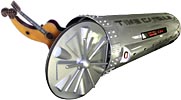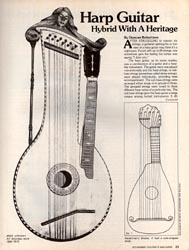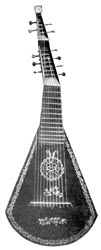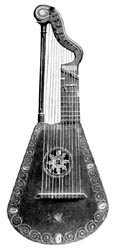|
Featured Harp Guitar of the Month |
|
|
Harp Guitar: Commentary by Gregg Miner, Dec, 2006
|
| Duncan Robertson’s article may
have been the first presentation on harp guitars in a modern mainstream
publication. His title indicates his focus, which is on historical
instruments that preceded harp guitars. Ironically, as it turns out,
Robertson spends most of his time talking about everything but
harp guitars. As we can deduce from the accompanying illustrations (and the instruments he discusses), it is clear that his two primary resources were the well-known Anthony Baines book, European and American Musical Instruments, and the Grove Dictionary. From these he re-drew five instruments for the illustrations in his article (I include the original images below). None are typical; one is recognizable as a harp guitar, one is an extremely unusual harp guitar, one is a hybrid instrument, and two are harp-lutes. Three additional harp guitars, which he had seen and photographed, round out the piece. And, again, one of these (which isn’t discussed) is by no means a typical representative example! |
Read the original article in PDF format. |
|
Robertson’s arbitrary examples and discussion serve as a good indication of where harp guitar organology was at the time. There wasn’t any! Anyone writing about them would invariably beat around the bush, either dodging or ignoring the classification issue (but in fairness, after struggling with my own thesis, I can easily understand why!). In what was perhaps the instrument’s first introduction to the myriad guitar players of the world, Robertson mentions some history, but mainly shows and discusses some random examples of curious hybrids or instruments that are at best only similar to true harp guitars. All good stuff - except that without context or clarity, the reader would have likely ended up more confused about what a harp guitar was than ever! Note Robertson’s spelling in the title and throughout the text. Was he the person that first used, and in this major magazine thus popularized, the current spelling of “harp guitar”? |
| After a brief, and somewhat puzzling, introduction, Robertson begins with the Naderman bissex. I wonder if he was the first person to state that the bissex was the “first true harp guitar.” It’s interesting that he got his information from Baines, who was always pretty careful not to specifically categorize such original instruments. Though he lists it for convenience under the heading "Bass and Compound Guitars," Baines' remarks (with phrases like "amounts to...a guitar or lute...") illustrate that he considers it a wholly original instrument. It’s a tough call; John Doan would repeat this opinion in his own 1988 Frets article and scholar Stephen Sedgwick concurs. As Harpguitars.net readers well know, I agree with Baines that the bissex, with its distinctly lute-like body, is a unique hybrid harp guitar-like instrument. |  |
|
|
More confusing – and there is really no way around it – are the harp-lutes. It’s unfortunate that Robertson felt the need to focus on them so much - perhaps it was because the Baines book, and certainly the Grove, were short on real harp guitars. Here we have yet another instrument that incorporates the concept of a fretted neck combined with floating strings, a classic case of a simple, well known idea or feature being applied once again to a different - or in this case, brand new - instrument. The reason these fascinating harp guitar “cousins” keep cropping up in our discussions is the problematic fact that the inventor Light named his first instrument – a harp-lute family member with no floating strings – a “Harp-Guitar.” As it appears to have been the first proven application of the term, much ado is made of it, and of course, it must necessarily be mentioned in the context of semantic history. At least Robertson makes clear that this first-named instrument was “not a true harp guitar,” though it’s a grievous error to describe it as “simply an 8-string guitar,” as it was specifically designed to be very different from, and compete against, the guitar. By the time Robertson finishes with other examples of Light’ subsequent instruments, along with very esoteric variations by Wheatstone and Ventura, he is way off topic. The article is more about the rare and unrelated harp-lute family than it is about the harp guitar! |
|
| Next up is another Baines book instrument, one of the few true harp guitars featured in the book. As it happens, it is again not very representative. In fact, it is one which, upon further reflection, I see that we need to track down and study! It is listed as a “J. G. Schirzer,” which we presume to be a misspelling of the famous Scherzer. Yet the instrument doesn’t resemble his instruments. An even stranger feature is that it has a second internal soundboard strung with wire sympathetic strings! This instrument, in the Copenhagen Museum, definitely needs to come out of the mothballs and be investigated. I’m not sure why Robertson finds it “similar to Naderman’s Bissex,” but it’s his article. |  |
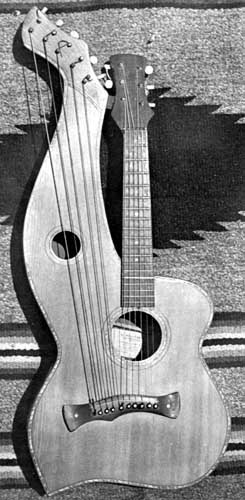 |
After this briefest mention of European harp guitars, Robertson finally closes with a very few short paragraphs on American harp guitars. As we are able to interpret the typographical error, he meant either “by 1880” or “by 1890” as the date harp guitars had become popular in the States. Perhaps he got this from Christian’s comments (in our other Time Capsule feature this month) – as there is almost no evidence that harp guitars were around before 1890 in America, let alone popular. I’m certain that the “ukulele-sized” harp guitar he refers to was simply a hollow arm Knutsen harp uke. His photo of the Knutsen ¾ scale harp guitar later appeared in Bob Hartman’s books, and is Inventory # HGS12 in the Archives. His Gibson info is OK., Technically, no one knows whether Orville himself designed the harp guitars, though Benoît and I (and Dan Beimborn) think so. And 1902 or 1903 would have been when they were introduced, rather than having four models “by 1903.” |
 |
|
One instrument left, and it is amazing! This seems to technically be a true harp guitar alright, but unlike any other. In fact, I placed it long ago in the Other Forms Gallery, as it really doesn't fit anywhere else. It's more like a backwards zither, with a short guitar neck replacing the concert zither fretboard. Nothing is said about it, but I wonder if the stringing of those extra strings are what Robertson is referring to in his inexplicable description of historical harp guitar sub-bass strings. He describes them as being either single, or “in groups of three,” the grouped strings “tuned to three different bass notes of a particular key.” I have never seen an instrument like this (other than in that one wacky photo of those homemade “chord group”-strung harp guitars). Certainly, no one would want to play three bass notes simultaneously. Perhaps he interpreted the twelve evenly spaced harp strings of his “Art Noveau style” harp guitar as being tunable in this fashion. Perhaps the existing strings (9 of the 12 – don’t be confused by the shadow lines which are those on the left) were found in this tuning. Pretty cool if so! They are certainly not thick bass strings, so though the even spacing suggests a 12-note chromatic scale, they may have been utilized for higher-pitched chords. It does look more like a zither than a guitar, so someone could easily have borrowed the “chord groups” tuning from any number of the ubiquitous fretless zithers of the era. For this concept to work though, that guitar neck can’t be anything close to a standard scale. If it is, this would be one impressive instrument indeed! The instrument was photographed by Robertson, so only he or its owner can help us with this one. I briefly tracked down Duncan in the late 1990s (looking for Knutsen info) but didn’t ask him about it (and his memory on all this stuff was very hazy). It’s amazing to me that, even with the Internet and the visibility of this site, there are semi-documented instruments as distinctive as this one that can still disappear and remain completely hidden and inaccessible for further study. It’s out there somewhere! |
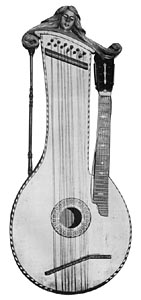 |
|
A
Harp Guitar |
|
More Time Capsules! |
||
| Player of the Month | Luthier of the Month |
After Six |
|
The Harpguitar: Its History and
Its Only Practitioner (Guitar Player, March, 1976) |
William Eaton (Frets, 1983) |
Playing the Harp Guitar (Frets, 1988) |
|
Harp Guitar of the Month: Archives |
| Collectors, Authors, Scholars: Want to create a page
about a certain harp guitar maker or instrument?
Contact me!
If you enjoyed this article, or found it useful for research, please consider supporting Harpguitars.net so that this information will be available for others like you and to future generations. Thanks!
|
